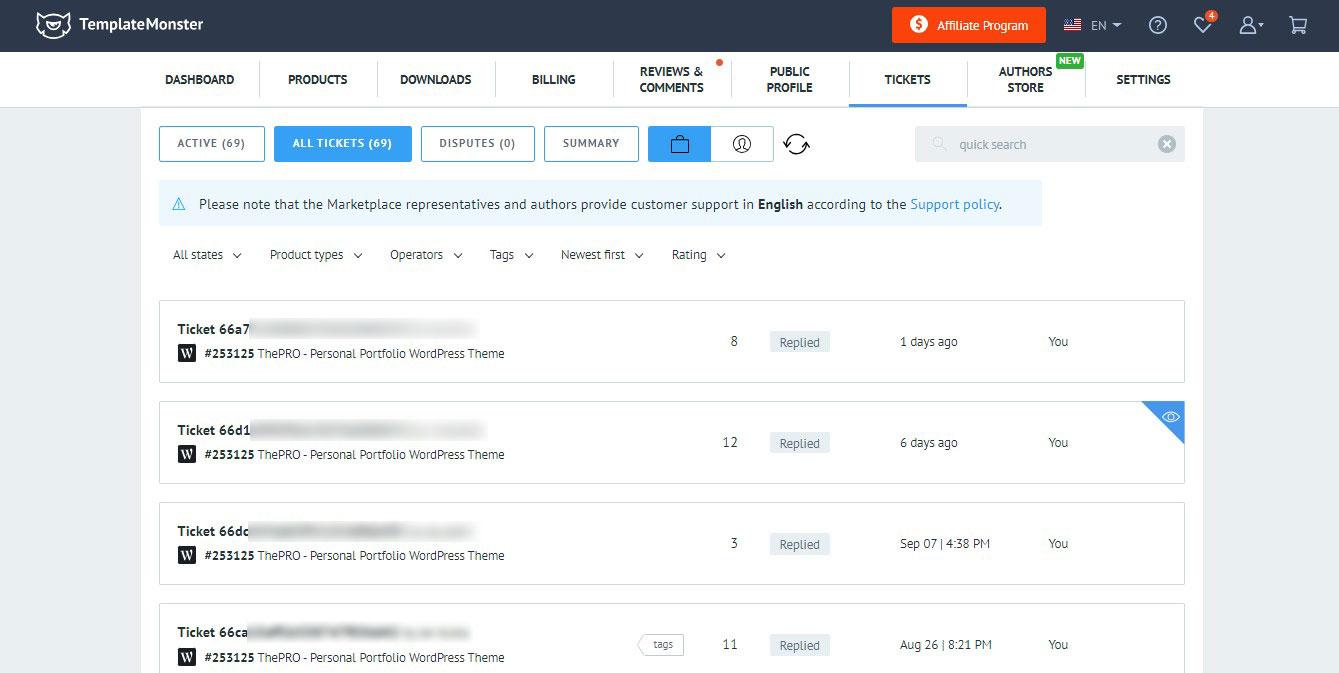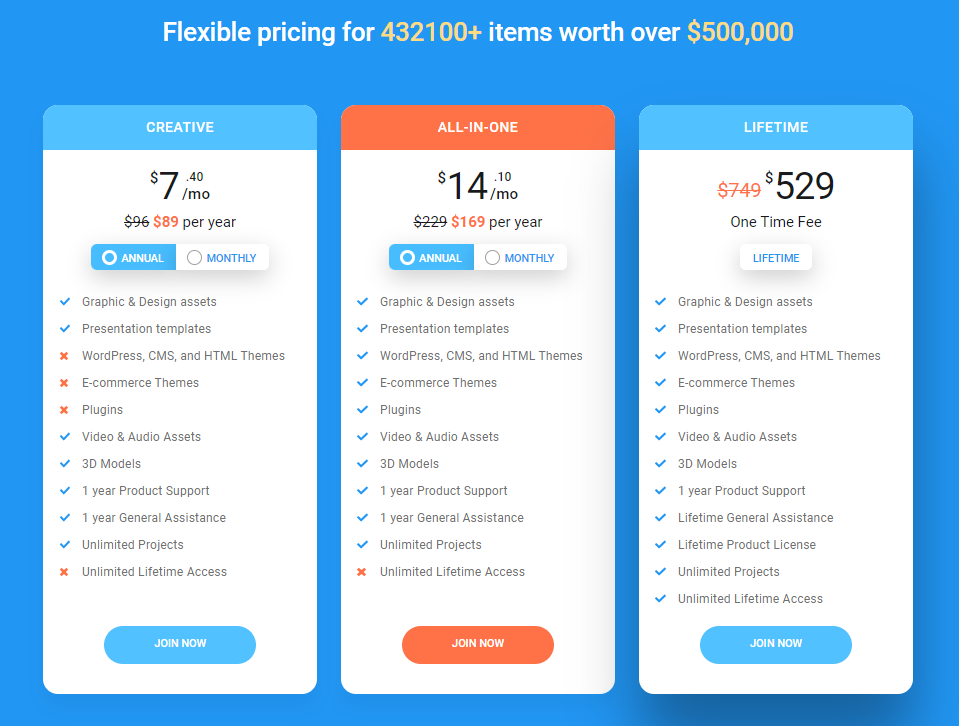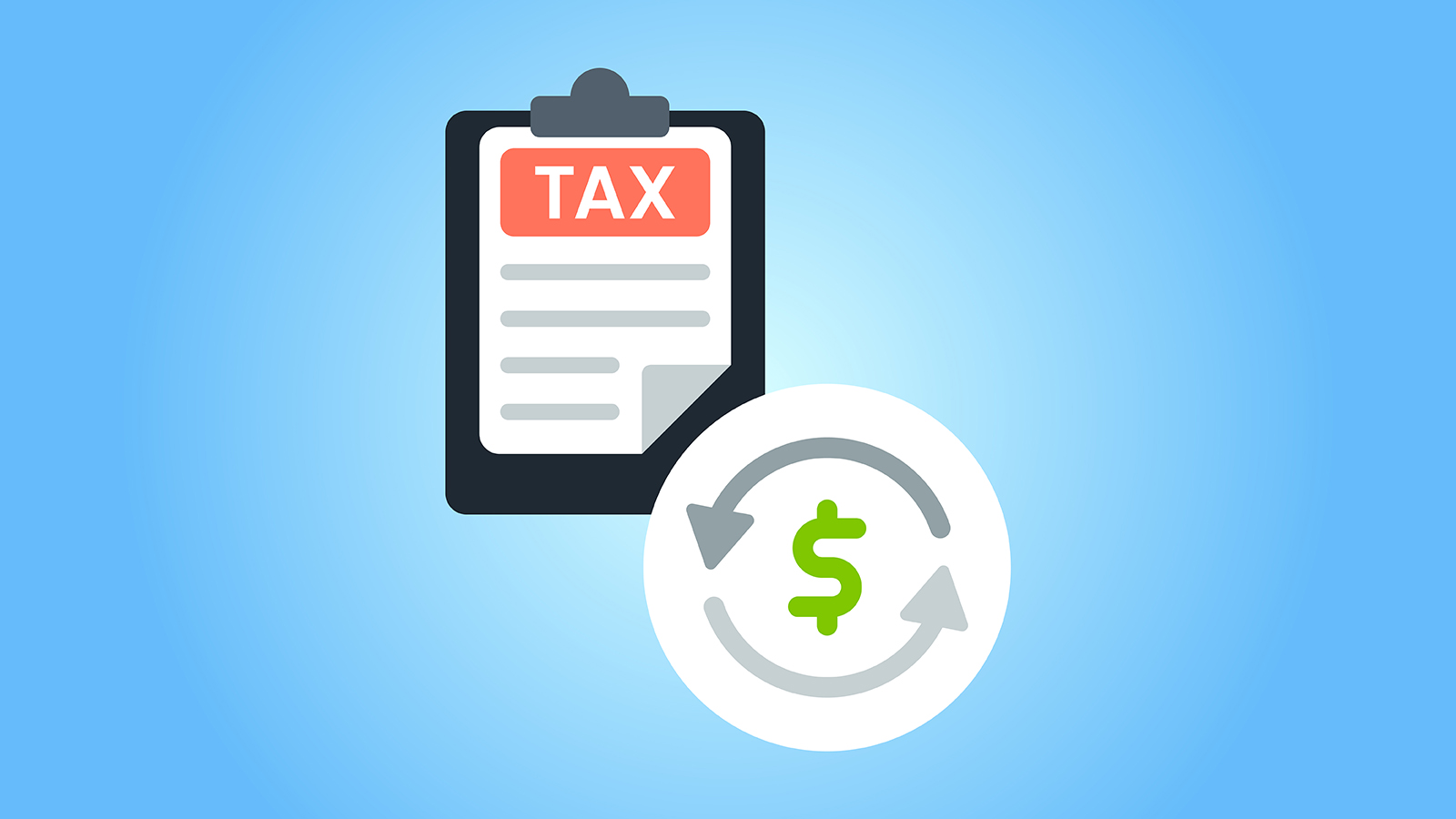|
|
Following Shutterstock’s acquisition of Envato, many WordPress software makers are searching for new alternatives. One popular option is TemplateMonster, a well-known digital marketplace that offers a wide selection of high-quality website templates and digital assets for different platforms.
At the time of writing, it has 5k+ WordPress themes and nearly 200 plugins in its inventory.
Is listing your products on TemplateMonster worth paying a (high) fee for your hard-earned sales? Or should you consider other options? To get the full picture, I spoke with four industry experts:
- Freemius founder and CEO Vova Feldman, who has helped many makers shift away from marketplaces and sell through their own online stores for over a decade.
- Ilyas Benhadda, WordPress theme developer and one of the top authors on TemplateMonster.
- Freemius VP of Engineering Swashata Ghosh, who has experience selling products on WordPress marketplaces.
- Freemius CTO Dror Yaakov, who has valuable insights into the challenges and opportunities faced by product sellers on marketplaces.
Let’s dive in.
A Brief History of TemplateMonster
TemplateMonster launched in 2002 — a year before WordPress itself — and was initially a web design studio servicing big companies, including a few from the Fortune 500 list. The company’s original goal was to create HTML and Flash templates for websites.
The first WordPress theme was only listed on TemplateMonster in 2006.

Partnership with WordPress
At one stage, TemplateMonster was WordPress’s official vendor.
TemplateMonster terminated this agreement when WordPress chose to only cooperate with suppliers operating under the GPL license. WordPress requires all themes and plugins distributed on its platform to adhere to GPL, which allows users to freely use, modify, and distribute the software.
“TemplateMonster, which was selling themes that didn’t fully comply with the GPL, found it challenging to align with these requirements,” Vova adds. “This licensing conflict caused TemplateMonster to focus on its own marketplace and other platforms.”
As founder and former CEO David Braun states in this 2019 interview: “To be honest, we did not get along with the WordPress community at first. As a representative of a commercial business, I could not find the meaning of the open-source world.”
Transition to a Marketplace Model
TemplateMonster went the marketplace route in 2019.
They started by selling their own themes, signaling to third-party software makers that they could also sell on the platform.
External development teams and companies — some of which TemplateMonster founded — were also commissioned to create premium themes to sell on their marketplace. This was a brilliant strategy with a win-win outcome for all parties involved.
“TemplateMonster used this approach to build a collection of high-quality products that people wanted, while still making it seem like many different creators were involved,” Vova clarifies. “Third-party makers gained access to a large audience and learned which themes were popular, helping them create products that had a built-in audience and sold well. This made the marketplace successful, with a range of in-demand themes that kept customers happy and drove sales.”
With the history and evolution covered, let’s get into the stats and info 🤓
Selling WordPress Themes and Plugins on Template Monster: The Fine Print
| Number of themes and plugins on TemplateMonster | 5249 WordPress themes and 183 plugins. |
| Who owns TemplateMonster? | A private equity firm. It was sold in 2013, under the condition that the founder David Braun remain CEO until 2020. |
| Price range of themes on TemplateMonster | $24–$280 |
| Price range of plugins on TemplateMonster | $9-$60 |
| Does TemplateMonster offer analytics or customer insights to sellers? | Yes. The Author Cabinet includes the following:
|
| Does TemplateMonster help sellers with exposure, traffic, or marketing? |
|
| Does TemplateMonster offer exclusivity? | Yes. Makers receive 50–65% percent commission for selling exclusively, depending on how many sales they make.
Non-exclusive makers receive a flat rate of 40% commission, regardless of the number of sales. It’s worth noting that TemplateMonster lets product makers set their own prices for their products. |
| Number of purchased themes and plugins on TemplateMonster | Although this information is not available, the platform has more than 2 million monthly visitors. |
| Does TemplateMonster have a tutorial page or forum for product makers? | Yes. It’s called MonsterHelp. |
| Does TemplateMonster have a customer forum? | No, but it does have a Web Maintenance Service that provides users with direct support and ongoing assistance. |
| Does TemplateMonster offer subscriptions for updates? | No. |
| Does TemplateMonster offer support subscriptions? | Yes. Customers get six months of support with the initial purchase and can opt to buy a “corresponding offer” (usually 30% of the product’s price) for six more months of support with the initial purchase.
During this additional support period, customers can buy six months’ more support at 45% of the product’s price. Should customers wish to buy support after the support periods have expired, they may renew it at 75% of the purchase price. Click here for TemplateMonster’s support policy. |
| Does TemplateMonster offer lifetime support? | No. |
| How does TemplateMonster billing work? | There are two billing options.
Authors can choose to get paid automatically on the 25th of each month if a minimum balance of $1,000 commission is reached. Or: Manually withdraw their commission if there is a minimum balance of $100 in their account for PayPal and Payoneer, and $500 for wire transfer. |
| Does TemplateMonster handle taxes? | No. When software makers automatically withdraw money, they are required to fill in a tax declaration form. |
| Does TemplateMonster offer multi-currency support? | No. |
| How does TemplateMonster’s checkout process work? | At checkout — as seen here — customers are given the option to purchase either a personal license (for private use on one website) or a commercial license (which allows them to redistribute and use the theme on five different websites).
Customers can also purchase additional services which include:
Customers can also opt to purchase extended support for six months. |
| Does TemplateMonster have an affiliate program? | Yes. If affiliates refer new sellers to TemplateMonster, they receive a 30% commission for a new buyer’s first purchase and 10% on all purchases the buyer makes thereafter. |
Now that we’ve covered the details of selling on the platform, let’s break down the pros and cons.
TemplateMonster Pros
Effective marketing strategies, a robust affiliate program, a centralized product/sales/customer dashboard, and investment in the WordPress ecosystem are the main advantages of selling WP products on TemplateMonster.
Great Marketing
“As a developer, you don’t always have the time or expertise to market your products. I remember once scrolling through Facebook or Instagram and seeing a sponsored post from TemplateMonster showcasing my products, which was a pleasant surprise,” Ilyas mentions.
As seen in the table, TemplateMonster offers a Product Promotion guide to help software makers market their products right after release by leveraging social media and backlinks. Another guide explains how to get your product featured under the Trending filter. This transparency is refreshing, offering clear steps for new product makers to gain traction and visibility.
“There are valid concerns about being pushed down by the Best Sellers algorithm or the need to pay for Product Boosters,” Vova says. “But for many sellers, the marketing resources offered by TemplateMonster outweigh the issues.”
A Robust Affiliate Program
“TemplateMonster’s strong affiliate program drives more traffic to the platform, which further benefits software makers,” Ilyas explains. “By allowing experienced marketers and advertisers to sign up as affiliates, it creates an additional promotional channel for products.”
Affiliates actively market and promote listings through their networks, which increases visibility and, ultimately, sales. In exchange, they earn a commission on every sale they generate.
“The affiliate program helps amplify your reach and opens up new sales opportunities without requiring extra effort on your part,” Ilyas says.
Maximizing Efficiency with Author Cabinet
One of the standout advantages of selling on TemplateMonster is the functionality provided by the Author Cabinet dashboard.
“It simplifies managing products, sales, and customer interactions all in one place,” Ilyas explains. “Its user-friendly interface makes it easy to upload and update WordPress themes and plugins, track sales performance, and manage payouts.”
However, Ilyas insists that what truly makes the Author Cabinet shine is the built-in ticketing system. “It organizes all inquiries in one place, making for quick and efficient responses. This saves time, allowing me to focus on creating better products and serving customers more effectively.”

Investment in the WordPress Ecosystem
Many WordPress product makers are exploring alternative marketplaces following Envato’s acquisition by Shutterstock. A key reason is the growing disconnect between Envato and the WordPress ecosystem.
TemplateMonster changed hands in 2013 when David Braun and his partners sold the company to a US private equity fund, with Braun staying on as CEO until 2020. Despite this shift in ownership, TemplateMonster hasn’t completely lost touch with the WordPress community.
“While private equity firms typically focus on maximizing profit — which may seem at odds with the open source nature of WordPress — TemplateMonster is nonetheless actively pursuing innovation within the WP ecosystem,” Vova says. “For example, they offer a suite of tools and add-ons specifically for Elementor — one of the most popular WordPress page builders — through their Crocoblock brand.”
But TemplateMonster’s advantages come with valid concerns and drawbacks.
TemplateMonster Cons
TemplateMonster’s shortcomings include low developer commissions, intense competition, a perceived disconnect from the WordPress ecosystem, and a low-cost subscription service that undercuts theme and plugin sellers.
Low Developer Commissions
TemplateMonster charges high fees, with makers receiving 50–65% commission for exclusive sales and 40% for non-exclusive sales. While these fees might seem steep, sellers often feel compelled to accept them due to a Catch-22 situation.
“The resources and platform they provide are things you can’t easily replicate yourself,” Ilyas explains. “I wouldn’t mind if the commissions were lower, but unfortunately, high fees seem to be the industry standard for marketplaces. As a result, you have little choice but to accept them.”
Tough Competition
“One of the biggest cons of selling on TemplateMonster is the intense competition,” Ilyas says. “With so many WordPress themes and plugins available, standing out becomes a real challenge.”
This is particularly tough for new sellers, as the high level of competition often demands extra marketing efforts and additional work.
“To beat the competition and succeed, your product needs to be unique — something that stands out from what’s already available in the marketplace. TemplateMonster tends to promote innovative ideas and unique products more effectively, but differentiating your offerings is often easier said than done.”
A Likely Disconnect With the WordPress Ecosystem
While TemplateMonster shows a strong investment in WordPress and makes solid efforts to promote sellers’ products, there are signs that the company may be out of touch with current trends and developments in the WordPress industry. This highlights a potential misalignment between what WordPress makers need and TemplateMonster’s current position, as well as where the company is headed.
“TemplateMonster’s marketing team reached out to Freemius for a collaboration, which surprised us,” Vova says. “If they fully understood our competitive position, they probably wouldn’t have. This confusion likely comes from their private equity owners, who aren’t WordPress product makers and may not fully understand the market.”
If TemplateMonster lacks a deep understanding of how the WordPress ecosystem works or where it’s going, sellers may not get the exposure, tools, or community support they need to grow their businesses successfully on the platform.
An additional development worth noting is TemplateMonster’s all-in-one subscription service, which comes with its own pros and cons.
Subscribe and grab a free copy of our WordPress Plugin Business Book
Exactly how to create a prosperous WordPress plugin business in the subscription economy.

There’s a New Monster in Town
Following in the [problematic] footsteps of Envato Elements — which you can read about here — TemplateMonster launched MonsterONE in 2019. It offers users unlimited access to various digital assets, including WordPress themes, website templates, graphics, audio and video files, and more.
Three subscription options are available:
- CREATIVE: $89 annually/$18 monthly, offering access to limited inventory types (excluding WordPress themes) without unlimited lifetime access
- ALL-IN-ONE: $169 annually/$59 monthly, offering access to all inventory types but without unlimited lifetime access.
- LIFETIME: $529 one-time fee, offering access to all inventory types with unlimited lifetime access.
All of these packages also include one year of product support and general assistance instead of the usual six months’ support on TemplateMonster’s individual WordPress themes.

However, there’s a difference between MonsterONE versus Envato Elements’ business model.
Whereas all Envato Elements’ packages offer unlimited downloads of Envato’s inventory, TemplateMonster curates and selects authors for MonsterONE. It prefers authors with high-quality products: specifically, those who have excellent track records and more than 10 products in their inventory.
How Does MonsterONE’s Profit Calculation Work?
According to MonsterONE’s profit calculation policy, the subscription money is split between the authors and the platform.
Each month, MonsterONE collects subscription fees from all customers, who can download as many products as they want. Half of that subscription revenue goes to MonsterONE, and the other half is set aside for the authors.
The author’s share is then divided based on two factors:
- How many downloads each author’s products get.
- A points system that gives more value to certain types of products, which affects how much each author earns.
For example, if a customer pays $14.10 for a subscription and downloads two products, $7.05 will be divided between the authors of those products based on the rules above.
However, as Dror points out, this model makes it hard for authors to predict their monthly earnings, leading to uncertainty. While TemplateMonster receives steady subscription fees, authors only get paid when their products are downloaded.
Is MonsterONE Beneficial for Authors or Not?
There are a few factors to consider.
Dror points out, “One month you can have 10 downloads, and the next only 1, making it impossible to calculate monthly recurring revenue (MRR) accurately.” This creates a revenue imbalance. Overall, Dror says, “MonsterONE seems like a big win for TemplateMonster but takes away potential revenue from authors.”
Can authors still make good money on MonsterONE? According to Swas, it depends on popularity. “To earn well on such a platform, the author needs to be well-known. There are already established products on MonsterONE, so the chances of consistent downloads for newer products are low.”
Swas also highlights the competition: many authors offer similar products, leading to a situation where users download multiple items every month, diluting earnings. “In my experience, as more similar products are added, author earnings drop. Plus, if your product is already popular on TemplateMonster, why use MonsterONE unless it’s bringing in more traffic?”
From web design studio to comprehensive digital marketplace to all-in-one subscription service — what is Template Monster’s current position in the WordPress market, and where is it headed?
TemplateMonster: Adapting or Lagging?
TemplateMonster boasts a diverse portfolio that includes thousands of WordPress themes and more than a hundred plugins. Despite challenges and changes in ownership, it continues to play a vital role in the WordPress ecosystem and has become a go-to platform for product makers and buyers alike.
However, selling on the platform has its challenges. High fees, intense competition, a perceived disconnect with WordPress, and the introduction of MonsterOne create obstacles for sellers, making it challenging to succeed on the platform.
As a result, many WordPress makers are choosing to take control by selling their products through their own online stores and partnering with a merchant of record like Freemius.
A merchant of record (MoR) handles transactions for a business, including payment processing, tax collection, and compliance with financial regulations, ensuring all legal and financial obligations are met.
If you’re interested in learning more about stepping beyond traditional WordPress marketplaces and managing your sales independently, reach out to us at [email protected].








